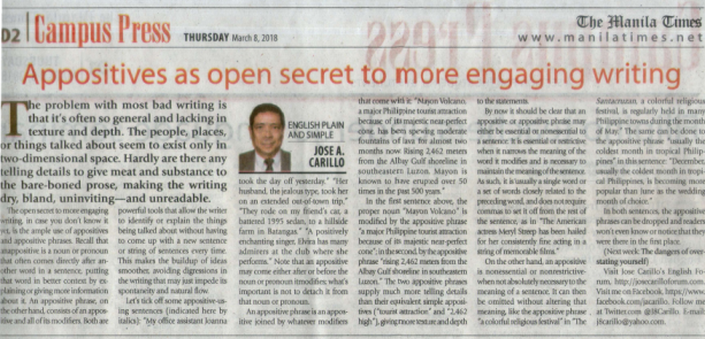The problem with most bad writing is that it’s often so general and lacking in texture and depth. The people, places, or things talked about seem to exist only in two-dimensional space. Hardly are there any telling details to give meat and substance to the bare-boned prose, making the writing dry, bland, uninviting—and unreadable.
An open secret to more engaging writing, in case you don’t know or don’t realize it yet, is the ample use of appositives and appositive phrases. Recall that an
appositive is a noun or pronoun that often comes directly after another word in a sentence, putting that word in better context by explaining or giving more information about it. An
appositive phrase, on the other hand, consists of an appositive and all of its modifiers. Both are powerful tools that allow the writer to identify or explain the things being talked about without having to come up with a new sentence or string of sentences every time. This makes the buildup of ideas smoother, avoiding digressions in the writing that may just impede its spontaneity and natural flow.
Let’s tick off some appositive-using sentences (indicated here by italics): “My office assistant
Joanna took the day off yesterday.” “Her husband
, the jealous type, took her on an extended out-of-town trip.” “They rode on my friend’s car
, a battered 1995 sedan, to a hillside farm in Batangas.” “
A positively enchanting singer, Elvira has many admirers at the club where she performs.” Note that an appositive may come either after or before the noun or pronoun it modifies; what’s important is not to detach it from that noun or pronoun.
An appositive phrase is an appositive joined by whatever modifiers that come with it: “Mayon Volcano,
a major Philippine tourist attraction because of its majestic near-perfect cone, has been spewing moderate fountains of lava for almost two months now.
A mountain rising 2,462 meters from the Albay Gulf shoreline in southeastern Luzon, Mayon is known to have erupted over 50 times in the past 500 years.”
In the first sentence above, the proper noun “Mayon Volcano” is modified by the appositive phrase “a major Philippine tourist attraction because of its majestic near-perfect cone”; in the second, by the appositive phrase “a mountain rising 2,462 meters from the Albay Gulf shoreline in southeastern Luzon.” The two appositive phrases supply much more telling details than their equivalent simple appositives (“tourist attraction” and “2,462 high”), giving more texture and depth to the statements.
By now it should be clear that an appositive or appositive phrase may either be essential or nonessential to a sentence. It is
essential or restrictive when it narrows the meaning of the word it modifies and is necessary to maintain the meaning of the sentence. As such, it is usually a single word or a set of words closely related to the preceding word, and does not require commas to set it off from the rest of the sentence, as in “The American actress
Meryl Streep has been hailed for her consistently fine acting in a string of memorable films.”
On the other hand, an appositive is
nonessential or nonrestrictive when not absolutely necessary to the meaning of a sentence. It can then be omitted without altering that meaning, like the appositive phrase “a colorful religious festival” in “The Santacruzan
, a colorful religious festival, is regularly held in many Philippine towns during the month of May.” The same can be done to the appositive phrase “usually the coldest month in tropical Philippines” in this sentence: “December
, usually the coldest month in tropical Philippines, is becoming more popular than June as the wedding month of choice.”
In both sentences, the appositive phrases can be dropped and readers won’t even know or notice that they were there in the first place.
 This essay, 1082nd in the series, appeared in the column “English Plain and Simple” by Jose A. Carillo in the Campus Press section of the March 8, 2018 issue (print edition only) of
This essay, 1082nd in the series, appeared in the column “English Plain and Simple” by Jose A. Carillo in the Campus Press section of the March 8, 2018 issue (print edition only) of The Manila Times
, © 2018 by the Manila Times Publishing Corp. All rights reserved.(Next week:
The dangers of overstating yourself) March 15, 2018
CORRECTION TO THE MANILA TIMES PRINT EDITION OF THIS ESSAY:Due to a most unfortunate oversight, I was unable to reflect a major correction in the manuscript of the above essay in the manuscript copy that was published in
The Manila Times today, March 8, 2018. That unrevised manuscript carried the uncorrected 4th and 5th paragraphs of the essay, which incorrectly identify as an appositive this participial phrase from the sample sentence presented: “rising 2,462 meters from the Albay Gulf shoreline in southeastern Luzon.” That inadvertent participial phrase was meant to be constructed as this appositive phrase, “a mountain rising 2,462 meters from the Albay Gulf shoreline in southeastern Luzon.” As explained in the essay, a distinct feature of an appositive phrase is a noun that renames the key word referred to and puts it in better context by explaining or giving more information about it. In the example presented, that appositive is the noun “mountain,” in the absence of which the intended appositive phrase collapses ito a regular participial phrase.
My sincere apologies for the oversight that led to the error.